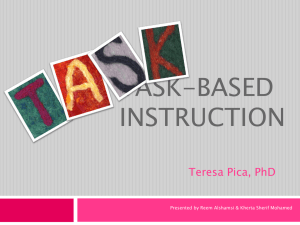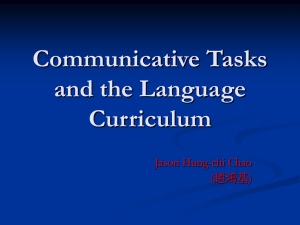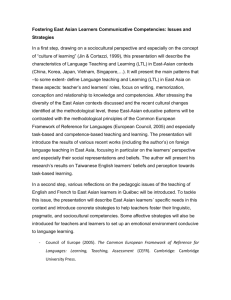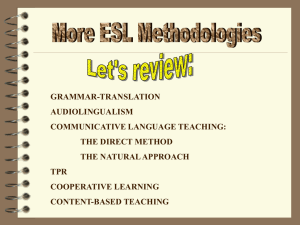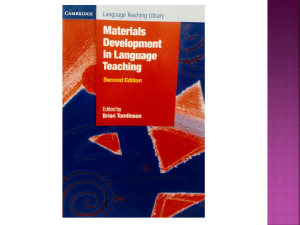THE CONCEPT OF FOREIGN LANGUAGE TASK,
advertisement
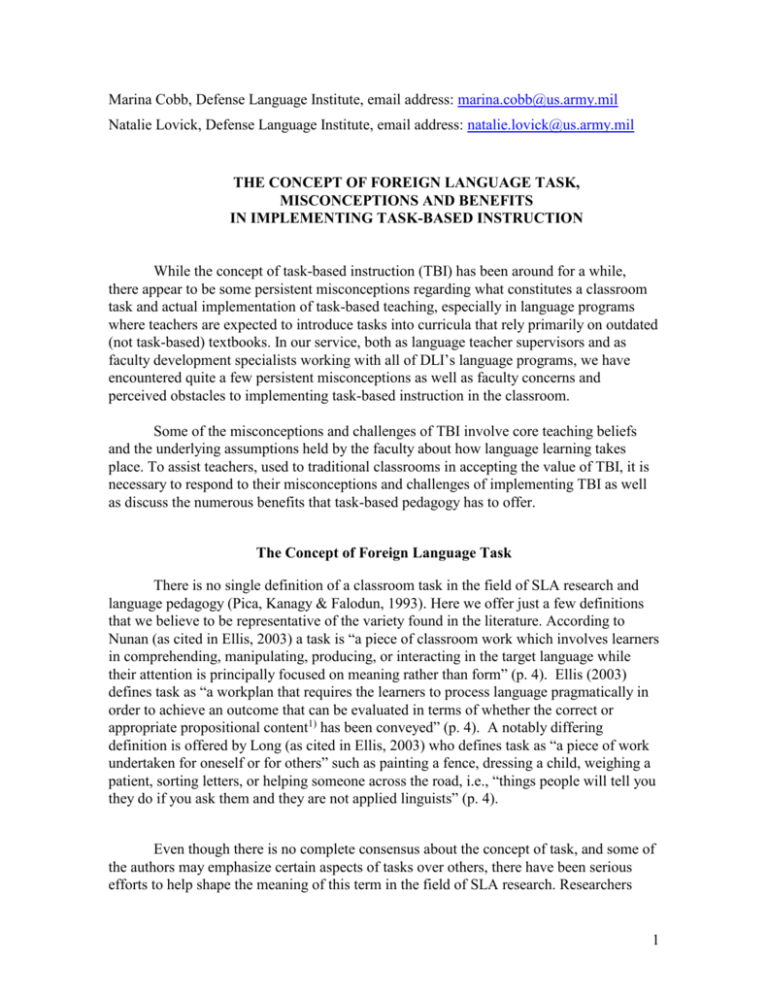
Marina Cobb, Defense Language Institute, email address: marina.cobb@us.army.mil Natalie Lovick, Defense Language Institute, email address: natalie.lovick@us.army.mil THE CONCEPT OF FOREIGN LANGUAGE TASK, MISCONCEPTIONS AND BENEFITS IN IMPLEMENTING TASK-BASED INSTRUCTION While the concept of task-based instruction (TBI) has been around for a while, there appear to be some persistent misconceptions regarding what constitutes a classroom task and actual implementation of task-based teaching, especially in language programs where teachers are expected to introduce tasks into curricula that rely primarily on outdated (not task-based) textbooks. In our service, both as language teacher supervisors and as faculty development specialists working with all of DLI’s language programs, we have encountered quite a few persistent misconceptions as well as faculty concerns and perceived obstacles to implementing task-based instruction in the classroom. Some of the misconceptions and challenges of TBI involve core teaching beliefs and the underlying assumptions held by the faculty about how language learning takes place. To assist teachers, used to traditional classrooms in accepting the value of TBI, it is necessary to respond to their misconceptions and challenges of implementing TBI as well as discuss the numerous benefits that task-based pedagogy has to offer. The Concept of Foreign Language Task There is no single definition of a classroom task in the field of SLA research and language pedagogy (Pica, Kanagy & Falodun, 1993). Here we offer just a few definitions that we believe to be representative of the variety found in the literature. According to Nunan (as cited in Ellis, 2003) a task is “a piece of classroom work which involves learners in comprehending, manipulating, producing, or interacting in the target language while their attention is principally focused on meaning rather than form” (p. 4). Ellis (2003) defines task as “a workplan that requires the learners to process language pragmatically in order to achieve an outcome that can be evaluated in terms of whether the correct or appropriate propositional content1) has been conveyed” (p. 4). A notably differing definition is offered by Long (as cited in Ellis, 2003) who defines task as “a piece of work undertaken for oneself or for others” such as painting a fence, dressing a child, weighing a patient, sorting letters, or helping someone across the road, i.e., “things people will tell you they do if you ask them and they are not applied linguists” (p. 4). Even though there is no complete consensus about the concept of task, and some of the authors may emphasize certain aspects of tasks over others, there have been serious efforts to help shape the meaning of this term in the field of SLA research. Researchers 1 generally make a distinction between tasks and so called non-tasks, which are mainly two types of activities: exercises and (unstructured) conversation. In this regard, it makes sense to refer to everything the students are asked to do in the classroom as “activities,” and among these to distinguish between activities that meet the established characteristics for tasks and those that do not. Based on the extensive literature review that we conducted in preparation to teaching the Faculty Development (FD) workshop on Task-Based Instruction for Department Chairs and Academic Specialists, we concluded that the concept of task has quite clearly taken on certain additional characteristics in the field of foreign language teaching. The following characteristics, or so called criterial features, can help the teachers distinguish between tasks and non-tasks: 1) Presence of a “workplan,” i.e., specific steps or a procedure that the students are instructed to follow (Ellis, 2003). This criterion distinguishes a task from a free-flowing conversational exchange. 2) Interaction between learners (Pica, Kanagy & Falodun, 1993). Hypothetically, tasks that are completed by one learner are also possible, e.g., a student is asked to listen to a passage describing someone’s travel route and trace it on a map. However, in line with the institutional guideline of promoting learner-centered instruction, it appears important to give primary attention to tasks that require students’ interaction which each other. 3) Non-linguistic purpose for the learners’ interaction (Ellis, 2003). When students are required to solve a problem, come to a consensus, or make a plausible prediction rather than being asked to create sentences using a particular grammatical structure, they use language for real life purposes rather than for language display, i.e., demonstrating that they can use the assigned structures correctly without creating and passing to others of any new meaning. 4) Manipulation of information, and not merely of language form (Nunan, 1989). This characteristic of tasks is related to the one previously stated: learners process, compare, analyze, and evaluate information, or derive/create new information from the given information. For example, an activity that would require students to rewrite a paragraph written in the present tense using past tense will only require them to manipulate form, not information, and, therefore, cannot be considered a task. 5) Involvement of cognitive, i.e., thinking processes that humans generally use in life outside of language learning (Willis, 2004). Examples of such cognitive processes are problem-solving, decision-making, justification, etc. 6) Connection to real-world functions (Ellis, 2003). Activities that require the students to fill out a reservation form or select the safest route for a trip simulate real world events, while filling in correct endings or prepositions does not. So called pedagogical tasks, e.g., reassembling a jumbled text or creating a plausible version of a news story based on the keywords provided, do not necessarily duplicate real world events or functions, 2 however, they have the potential to stimulate the same thinking processes and patterns of interaction that occur in the real world. 7) Presence of a so-called observable product or, for role play scenarios, a communicative outcome (Ellis, 2003). The concept of observable product or outcome is one of the most misunderstood notions related to task-based instruction. Examples of observable products are: solution to a problem, joint decision, reached consensus, list of identified discrepancies between two sources, identified suspect, a drawn map, floor plan or chart, etc. Once again, these are products of human activities that exist in the real world outside the language classroom. For this reason, correctly filled in grammatical forms do not qualify to be an observable product of a task, and the related activity is, therefore, not a task but rather an exercise. 8) Possibility of multiple outcomes (in most tasks) (Ellis, 2003). Since the outcome represents a product co-created by students in the process of their interaction with each other, typically there will be more than one “right” product. Certain tasks, however, may conceivably, be designed to have only one possible answer, e.g., if the students are asked to jointly complete an activity which is akin to a logical puzzle or a mathematical problem such as figuring out the most cost-efficient way of doing something. These eight features, in our opinion, are the most helpful in determining whether a particular classroom activity is a task or not. It is important to point out that classroom activities may also be viewed on a continuum with “Task” and “Non-Task” on the opposing ends of the continuum line. Various classroom activities may hypothetically fall on different parts of this continuum, e.g., certain communicative classroom activities may meet some or most, but not all, of the requirements for tasks. On an additional note, the distinction between task and non-task should not necessarily be understood as a distinction between “good” and “bad” or “acceptable” and “unacceptable.” On the one hand, most researchers and classroom teachers nowadays agree that there is a certain place for drills and exercises in FL classroom instruction. On the other hand, one can certainly encounter poorly designed or poorly implemented tasks. Common Misconceptions about Task-Based Instruction It is not surprising that the lack of complete consensus in the field about what constitutes a task, the abstract nature of some of the task characteristics presented in the literature combined with differing teacher beliefs about how language learning takes place result in a whole range of misinterpretations and misconceptions about the nature and role of TBI. The chart below summarizes and addresses some of the most pervasive misconceptions that we encountered in our TBI workshops. 3 Misconception Response/Explanation 1 Tasks are anything that the students are tasked with in the classroom. This misconception is based on the common definition of the word task in the English language and neglects the literature in the field of FL teaching which outlines specific characteristics of tasks as opposed to nontasks. 2 Any activity that involves speaking is The activity must meet most of the criterial a task features of a task. The process of interaction between learners alone (without an observable product) does not make it a task. 3 Any activity that involves pair work is a task The activity must have most of the other characteristics of a task to qualify to be one. Asking the students to fill in the grammatical endings in pairs does not constitute a task. Moreover, students may not respond well to being assigned to work in pairs to complete an activity that may be best done individually (a typical reason given by students for rejecting pair work in the classroom). However, in case of well-designed information gap2) or reasoning gap3) tasks, working in pairs or small groups makes sense to students, and complaints usually give way to excitement and appreciation. 4 Any assignment with the word create in it is a task. Asking students to create sentences with certain grammatical structures or vocabulary items does not appear to constitute a task in the opinion of most researchers. Similarly, it is questionable whether an assignment to create a paragraph about what one did on the weekend constitutes a task, since it only involves lower order cognitive processes of recalling and listing information. 5 Since learners interact for a nonlinguistic purpose, no language development takes place. This argument is frequently brought up by teachers who mistakenly equate language acquisition with learning about the language. Language learning however, occurs here as a 4 by-product of doing something else. Students learn best when doing something real while talking through the process in the target language when their mental and emotional investment is high. 6 Learners need to have mastered all the vocabulary and grammatical structures that are required for completion of a task before they can do this task in class. Learners practice and acquire new language features more effectively if they use them in the process of completing tasks due to deeper processing and higher cognitive investment involved. 7 Mastery of new vocabulary and patterns or demonstrated comprehension of a text can serve as the observable product of a task. Comprehension of input or improved use of new vocabulary and patterns are certainly things that we want to see from our students in the classroom. However, in and of themselves, perceived evidence of comprehension or learning does not constitute observable products of tasks, at least not in the sense in which the use of the term was intended. In other words, language learning benefits are not the same as the observable outcome of a task. We hope that all classroom activities bear some learning benefits for the students in terms of improved mastery of certain linguistic items. Nevertheless, in order to qualify to be called tasks, these activities also need to have a clear and tangible result, oral or written, e.g., report, proposal, list of arguments pro and con, etc., or non-verbal such as a drawing, a traced route, etc. 8 Tasks are always global activities; they can serve to improve target language fluency, but not accuracy in the use of specific language features. The literature discusses so called focused tasks which are designed to predispose learners to utilize specific language features such as vocabulary or grammar, e.g., LarsenFreeman’s (2001b) grammaring tasks4). It is true, however, that creating tight-focused, meaningful tasks that give the students a real purpose for interacting and induce the use of specific forms at the same time is much harder for teachers than creating unfocused tasks which target general fluency and facility with the language. With a little practice and 5 creativity, however, teachers can develop their own inventory of “grammaring” task ideas, some of which may be applied to a variety of structures. 9 Tasks are not related to the lessons in the course. “It is impossible to create tasks that focus on the current material.” Just as with focused “grammaring” tasks discussed above, the teachers can develop the skill of textbook adaptation, i.e., turning exercises into tasks, while keeping the same focus, scope, and time required to complete the activity. 10 Tasks are only to be used in Immersion, Bridges and other specially designated curricular events. Task-based instruction should be integrated into everyday classroom practice to break the routine and increase opportunities for deep processing of the language material. 11 Faculty do not have class time for tasks because they take at least 40-50 minutes to complete. There is no minimum time requirement for an activity to qualify to be a task. It is possible to design both unfocused (global) and focused tasks that will only require a few minutes to complete, especially at beginning levels. A task is not necessarily a chain of activities or a large-scoped, time-consuming project. 12 Tasks always require a lot of preparation on behalf of the teacher. A task may or may not require a lot of preparation time on behalf of the teacher, depending on the nature of the task. There are a number of publications with activity ideas, many of which are task-based in nature, requiring little or no preparation, e.g. Pollard and Hess’ Zero Prep: Ready-to-Use Activities for the Language Classroom (1997) and other sources available at the DLI AISO library. 13 Tasks can only be used for teaching speaking. Reading and listening cannot be taught through tasks. While it is true that the students cannot literally read or listen together, tasks do come in after the text has been read or heard. Many real-world tasks or pedagogical tasks can be created based on an input text that both bring out the comprehension of the text and take it to a new level of processing. 6 14 The Defense Language Proficiency Test (DLPT) is not task-based and, therefore, we should not use taskbased instruction in class. The faculty who bring up this argument may be overlooking an important difference between teaching for true language acquisition and so called “teaching by testing.” While filling in the blanks, answering specific content questions, or providing answers on a multiple choice test make it easy for a teacher to provide feedback as to the correctness of the answer, these activities, as pointed out earlier, are not necessarily conducive to internalizing the language material for long-term retention. These misconceptions, and others not addressed here, are the challenges that DLI faces in attempting to implement TBI in its language instruction. It is important to mention an important caveat that concerns the terminology of TBI. Ellis (2003) proposes differentiating between the terms task-based instruction (TBI) and task-supported instruction (TSI). In the pure form of TBI or task-based language teaching (TBLT), the task is the only unit of the curriculum and perhaps even assessment. TSI however, means incorporating tasks into the curriculum, which may also contain other types of activities. For the most part, it appears that, in published literature, authors use the term “task-based instruction” to refer to both, i.e., the term TBI is frequently used when the author actually means TSI. Therefore, when TBI is mentioned as the pedagogy being implemented at the DLI, strictly speaking, it is the TSI approach that is used in the curriculum. The important point here is there appears to be a consensus in the field of FL teaching (with few exceptions) that even though TBI is extremely useful in raising the learners’ proficiency, tasks are not the only type of activity to be used in a language program. DLI employs a number of teachers with traditional classroom background experience who often find it difficult to implement task-based teaching in their classrooms. They do not see language as a tool and their students as language users, but rather as just learners of a language (Ellis 2001). Therefore, in addition to responding and explaining the above misconceptions to faculty members, it is also important to examine the benefits of task-based pedagogy. This may convince teachers that TBI allows students to function as ‘language users’ in the real world and perform a wider range of language functions which correspond with the goals of proficiency-oriented language teaching and the DLI mission. The following section examines some of the benefits of TBI as found in the literature and also includes the contributions of the TBI workshop participants. Benefits of Task-Based Instruction An important benefit of TBI is the idea of collaborative learning. Pair and group work are seen as central elements of task-based teaching. According to education researchers and psychologists, peer interaction is one of the most successful forms of 7 cooperative learning because it has been shown to promote and support acceptance and social development (Slavin 1990; Wells, Ling & Maher, 1990). Tasks completed in small groups inevitably bring in the affective and social aspects of learning. When the students have to overcome initial confusion, possibly even frustration, and to mobilize all their resources to complete the task together despite cognitive clashes between themselves and their partners, they tend to internalize the language items used in the process better which, eventually, leads to better long-term retention. Completing tasks also helps students develop into self-reliant learners. Learners are allowed to show initiative, become active participants in the learning process, which leads to a sense of accomplishment, confidence and pride. This contributes greatly to developing social learning strategies and strategic competence. Motivation of learners is another benefit of TBI. Learners become motivated to use the language through hands-on activities allowing them to be creative and have a sense of ownership of the observable product that they are creating. They have a clear goal and nonlinguistic purpose to use the target language focusing their on meaning rather than form. TBI leads to proficiency in the language by integrating all four skills and contributes to an immersion environment in the classroom. As a result, each individual student produces more language than in teacher-centered classrooms. Research has shown that not only is language input important for second language acquisition to take place, but output also plays an important role. Output helps to increase the control that learners have over the structures that they have already acquired (Noboyushi & Ellis, 1993). Finally, there appears to be a consensus in the field that, by their very nature, tasks, which are essentially problem-solving activities completed jointly with others in the target language, require more investment of mental effort on the part of the learner. Therefore, they constitute deeper processing of the linguistic items that the learners use in the experience and have a potential of penetrating deeper layers of consciousness, thus facilitating true language acquisition. It is, therefore, necessary for teachers to be aware of what types of activities are more task-based in nature in order to make sure that they create conditions ultimately conducive to acquisition by consciously trying to introduce tasks into their teaching, especially if their textbooks provide few opportunities for task-based learning. Nunan (2006) gives the following main points about TBI which reflect the benefits that task-based pedagogy brings to the classroom: 1) TBI is characterized by an emphasis on learning to communicate in the target language through interaction of peers. 2) TBI promotes the use of authentic texts in the learning situation. 3) The learner’s own personal experiences are important contributing elements to classroom learning. 4) Classroom language learning is linked with real world language use. 5) The primary focus is on meaning rather than grammatical form. 6) Learners are allowed to freely use a range of language structures to achieve a nonlinguistic outcome. 8 The priority in language instruction at the current time is to create effective language materials based on SLA principles that promote learner-centered, hands on activities. TBI allows the learner “to learn by doing” which leads to a whole range of benefits for the learner as discussed in this paper. In addressing the misconceptions and benefits of TBI, we hope to convey to DLI instructors that TBI may lead their students to a higher level of proficiency by motivating the learner to communicate and use the target language as it is used in the real world. ENDNOTES 1) Propositional content is the speaker’s intent behind an utterance or a longer piece of discourse, e.g. to make a request, to express an objection, to persuade, etc. 2) Information gap tasks are tasks that are designed so that each of the participants in a small group or a pair holds information that the other ones do not have. The task design requires the participants to request and provide this information to each other. Ideally after everyone has all the information, the participants would be asked to do something meaningful with it (process or assess it in some way). The simplest way to create an information gap is to present only a part of a text to each participant (also known as a jigsaw activity). Another example of an information gap scenario is providing one student with the bus schedule and the other one with the schedule of interesting events in the city, then asking them to agree on how they would spend their day in the city without showing each other the respective schedules. 3) Reasoning gap tasks are tasks in which, unlike in information gap tasks, all participants have access to all the required information. Together, they have to figure out a puzzle that it presents, propose a solution to a real-life dilemma, agree on the best course of action, etc. 4) Grammaring tasks are communicative activities that are designed so that they engage the students in interaction with a real purpose (other than the display of correct linguistic forms), e.g. to solve a problem, predict, hypothesize, reach a consensus, find discrepancies, etc., but at the same time elicit the targeted grammatical forms repeatedly and thus allow the students to gain more meaningful practice with these forms than would be accomplished by drills or exercises. The term grammaring has been proposed by Diane Larsen-Freeman (Larsen-Freeman, 2001b) 9 REFERENCES Ellis, Rod (2003). Task-based Language Learning and Teaching. Oxford: Oxford University Press. Larsen-Freeman, D. (2001b). Teaching Language: From Frammar to Grammaring. Boston: Heinle & Heinle. Noboyushi, J. & Ellis, R. (1993). Focused communication tasks and second language acquisition. English Language Teaching Journal, 47, 203-210. Nunan, D. (2006).Task-based language teaching in the Asia context: Defining ‘task’. Asian EFL Journal, 8 (3). Retrieved September 16, 2007 from http://www.asian-efljournal.com/Sept_06_dn.php. Nunan, D. (1989). Designing Tasks for the Communicative Classroom. Cambridge: Cambridge University Press. Pica, T., Kanagy, R., & Falodun, J. (1993). Choosing and using communication tasks for second language instruction and research. In G. Crookes & S. M. Gass (Eds.), Tasks and language learning (pp. 9-34). Clevedon, UK:Multilingual Matters. Pollard, L. & Hess, H. (1997). Zero Prep: Ready-to-Use Activities for the Language Classroom. California: Alta Book Center. Slavin, R. (1990) Cooperative learning: Theory, research & practice. Englewood Cliffs, NJ: Prentice Hall. Wells, G., Ling, G., & Maher, A. (1990). Creating classroom communities and literate thinkers. In S. Sharan (Ed.), Cooperative learning: Theory and research (pp. 95121). NY: Praeger Willis, J.R. (2004). Perspectives on task-based instruction: Understanding our practices, acknowledging different practitioners. In B.L. Leaver & J.R. Willis (Eds.), Taskbased instruction in foreign language education (pp. 3-44). Washington, DC: Georgetown University Press. 10
